Longfei Yan
MonoCD: Monocular 3D Object Detection with Complementary Depths
Apr 04, 2024Abstract:Monocular 3D object detection has attracted widespread attention due to its potential to accurately obtain object 3D localization from a single image at a low cost. Depth estimation is an essential but challenging subtask of monocular 3D object detection due to the ill-posedness of 2D to 3D mapping. Many methods explore multiple local depth clues such as object heights and keypoints and then formulate the object depth estimation as an ensemble of multiple depth predictions to mitigate the insufficiency of single-depth information. However, the errors of existing multiple depths tend to have the same sign, which hinders them from neutralizing each other and limits the overall accuracy of combined depth. To alleviate this problem, we propose to increase the complementarity of depths with two novel designs. First, we add a new depth prediction branch named complementary depth that utilizes global and efficient depth clues from the entire image rather than the local clues to reduce the correlation of depth predictions. Second, we propose to fully exploit the geometric relations between multiple depth clues to achieve complementarity in form. Benefiting from these designs, our method achieves higher complementarity. Experiments on the KITTI benchmark demonstrate that our method achieves state-of-the-art performance without introducing extra data. In addition, complementary depth can also be a lightweight and plug-and-play module to boost multiple existing monocular 3d object detectors. Code is available at https://github.com/elvintanhust/MonoCD.
Cross Far- and Near-field Wireless Communications in Terahertz Ultra-large Antenna Array Systems
Jan 08, 2023Abstract:Terahertz (THz) band owning the abundant multi-ten-GHz bandwidth is capable to support Terabit-per-second wireless communications, which is a pillar technology for 6G and beyond systems. With sub-millimeter-long antennas, ultra-massive (UM) MIMO and intelligent surface (IS) systems with thousands of array elements are exploited to effectively combat the distance limitation and blockage problems, which compose a promising THz ultra-large antenna array (ULAA) system. As a combined effect of wavelength and array aperture, the resulting coverage of THz systems ranges from near-field to far-field, leading to a new paradigm of cross-field communications. Although channel models, communications theories, and networking strategies have been studied for far-field and near-field separately, the unified design of cross-field communications that achieve high spectral efficiency and low complexity is still missing. In this article, the challenges and features of THz ULAA cross-field communications are investigated. Furthermore, cross-field solutions in three perspectives are presented, including a hybrid spherical- and planar-wave channel model, cross-field channel estimation, and widely-spaced multi-subarray hybrid beamforming, where a subarray as a basic unit in THz ULAA systems is exploited. The approximation error of channel modeling accuracy, spectral efficiency, and estimation error of these designs are numerically evaluated. Finally, as a roadmap of THz ULAA cross-field communications, multiple open problems and potential research directions are elaborated.
Dynamic-subarray with Fixed Phase Shifters for Energy-efficient Terahertz Hybrid Beamforming under Partial CSI
Mar 29, 2022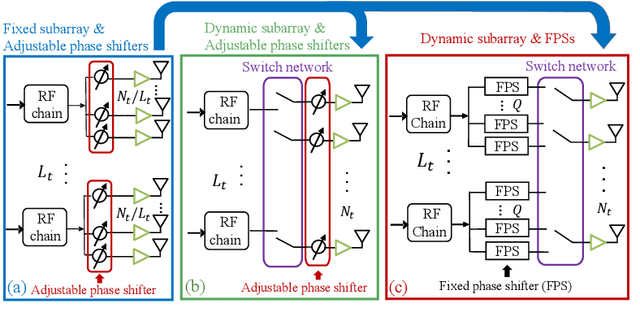
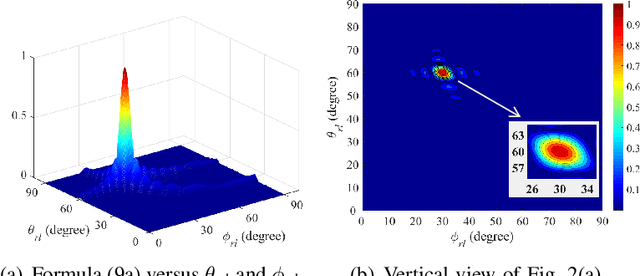
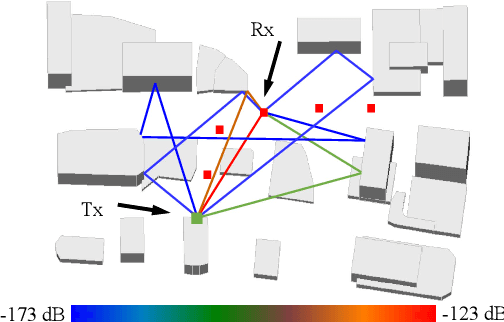

Abstract:Terahertz (THz) communications are regarded as a pillar technology for the 6G systems, by offering multi-ten-GHz bandwidth. To overcome the huge propagation loss while reducing the hardware complexity, THz ultra-massive (UM) MIMO systems with hybrid beamforming are proposed to offer high array gain. Notably, the adjustable-phase-shifters considered in most existing hybrid beamforming studies are power-hungry and difficult to realize in the THz band. Moreover, due to the ultra-massive antennas, full channel-state-information (CSI) is challenging to obtain. To address these practical concerns, in this paper, an energy-efficient dynamic-subarray with fixed-phase-shifters (DS-FPS) architecture is proposed for THz hybrid beamforming. To compensate for the spectral efficiency loss caused by the fixed-phase of FPS, a switch network is inserted to enable dynamic connections. In addition, by considering the partial CSI, we propose a row-successive-decomposition (RSD) algorithm to design the hybrid beamforming matrices for DS-FPS. A row-by-row (RBR) algorithm is further proposed to reduce computational complexity. Extensive simulation results show that, the proposed DS-FPS architecture with the RSD and RBR algorithms achieves much higher energy efficiency than the existing architectures. Moreover, the DS-FPS architecture with partial CSI achieves 97% spectral efficiency of that with full CSI.
Energy-efficient Dynamic-subarray with Fixed True-time-delay Design for Terahertz Wideband Hybrid Beamforming
Feb 07, 2022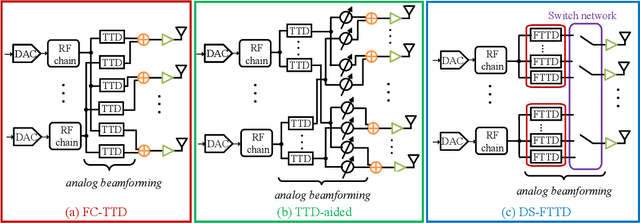
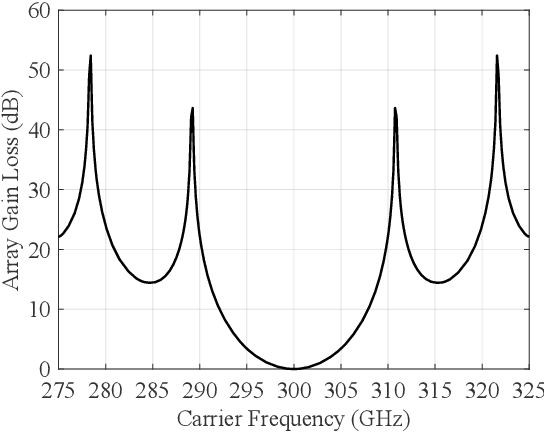
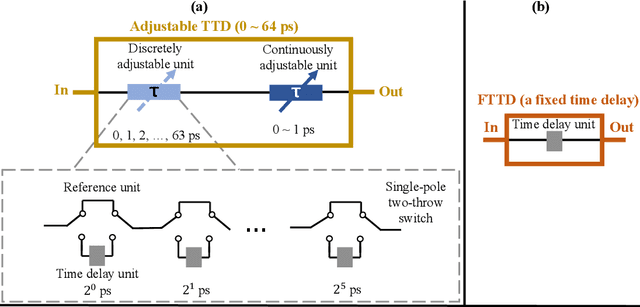

Abstract:Hybrid beamforming for Terahertz (THz) ultra-massive multiple-input multiple-output (UM-MIMO) systems is a promising technology for 6G space-air-ground integrated networks, which can overcome huge propagation loss and offer unprecedented data rates. With ultra-wide bandwidth and ultra-large-scale antennas array in THz band, the beam squint becomes one of the critical problems which could reduce the array gain and degrade the data rate substantially. However, the traditional phase-shifters-based hybrid beamforming architectures cannot tackle this issue due to the frequency-flat property of the phase shifters. In this paper, to combat the beam squint while keeping high energy efficiency, a novel dynamic-subarray with fixed true-time-delay (DS-FTTD) architecture is proposed. Compared to the existing studies which use the complicated adjustable TTDs, the DS-FTTD architecture has lower power consumption and hardware complexity, thanks to the low-cost FTTDs. Furthermore, a low-complexity row-decomposition (RD) algorithm is proposed to design hybrid beamforming matrices for the DS-FTTD architecture. Extensive simulation results show that, by using the RD algorithm, the DS-FTTD architecture achieves near-optimal array gain and significantly higher energy efficiency than the existing architectures. Moreover, the spectral efficiency of DS-FTTD architecture with the RD algorithm is robust to the imperfect channel state information.
Hybrid Spherical- and Planar-Wave Channel Modeling and DCNN-powered Estimation for Terahertz Ultra-massive MIMO Systems
Jun 10, 2021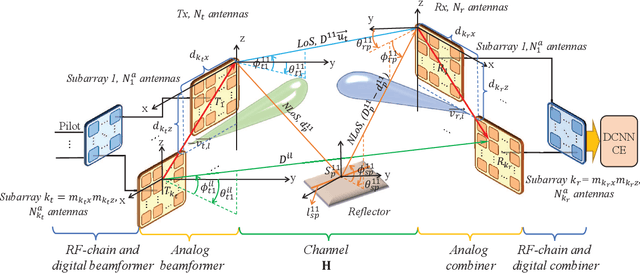
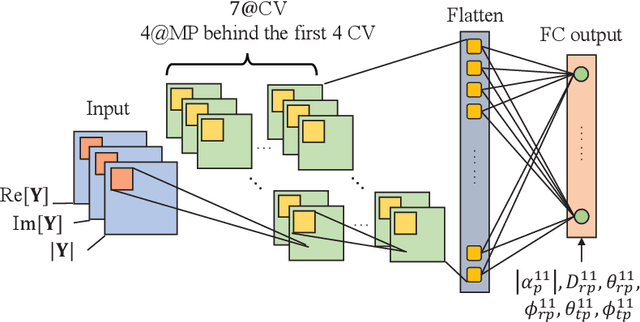
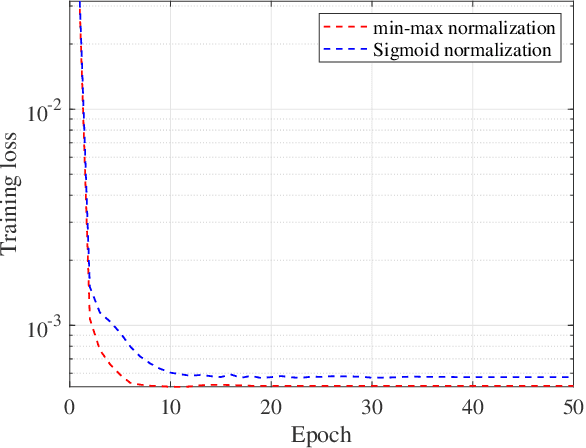

Abstract:The Terahertz band is envisioned to meet the demanding 100 Gbps data rates for 6G wireless communications. Aiming at combating the distance limitation problem with low hardware-cost, ultra-massive MIMO with hybrid beamforming is promising. However, relationships among wavelength, array size and antenna spacing give rise to the inaccuracy of planar-wave channel model (PWM), while an enlarged channel matrix dimension leads to excessive parameters of applying spherical-wave channel model (SWM). Moreover, due to the adoption of hybrid beamforming, channel estimation (CE) needs to recover high-dimensional channels from severely compressed channel observation. In this paper, a hybrid spherical- and planar-wave channel model (HSPM) is investigated and proved to be accurate and efficient by adopting PWM within subarray and SWM among subarray. Furthermore, a two-phase HSPM CE mechanism is developed. A deep convolutional-neural-network (DCNN) is designed in the first phase for parameter estimation of reference subarrays, while geometric relationships of the remaining channel parameters between reference subarrays are leveraged to complete CE in the second phase. Extensive numerical results demonstrate the HSPM is accurate at various communication distances, array sizes and carrier frequencies.The DCNN converges fast and achieves high accuracy with 5.2 dB improved normalized-mean-square-error compared to literature methods, and owns substantially low complexity.
Hybrid Beamforming for Terahertz Wireless Communications: Challenges, Architectures, and Open Problems
Jan 21, 2021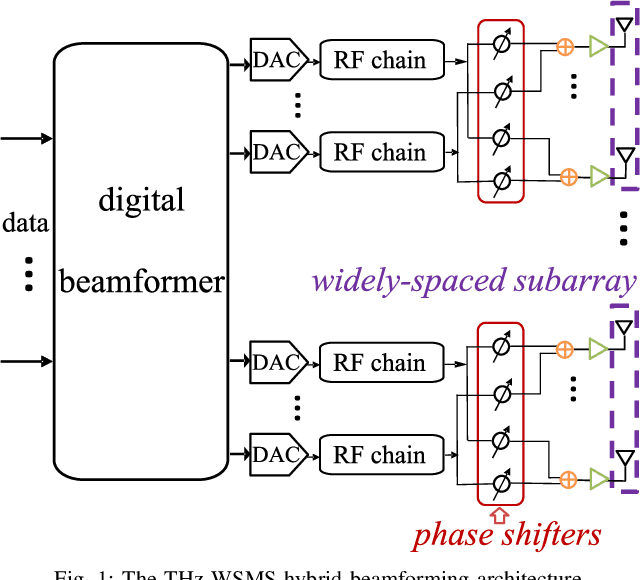
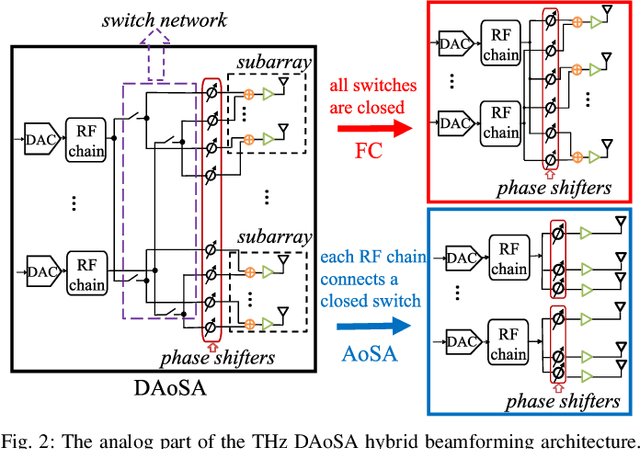
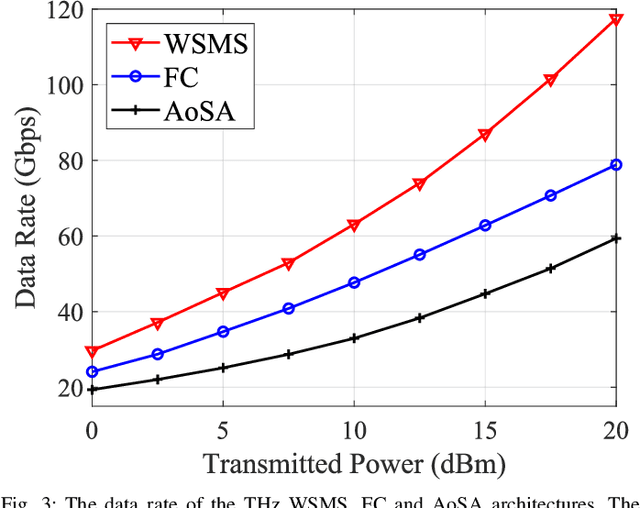
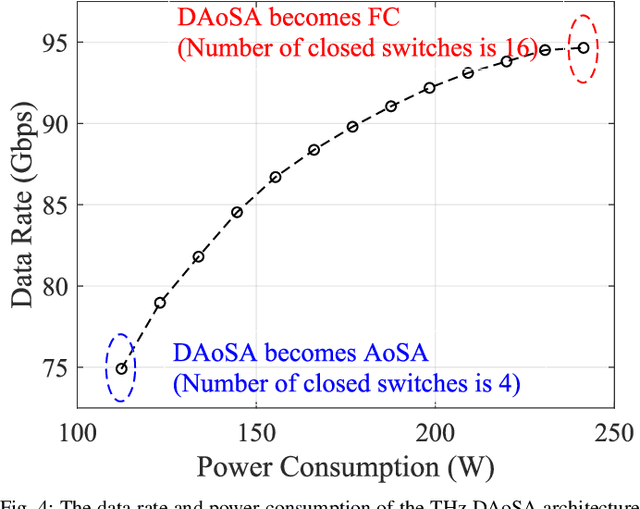
Abstract:Terahertz (THz) communications are regarded as a pillar technology for the sixth generation (6G) wireless systems, by offering multi-ten-GHz bandwidth. To overcome the short transmission distance and huge propagation loss, ultra-massive (UM) MIMO systems that employ sub-millimeter wavelength antennas array are proposed to enable an enticingly high array gain. In the UM-MIMO systems, hybrid beamforming stands out for its great potential in promisingly high data rate and reduced power consumption. In this paper, challenges and features of the THz hybrid beamforming design are investigated, in light of the distinctive THz peculiarities. Specifically, we demonstrate that the spatial degree-of-freedom (SDoF) is less than 5, which is caused by the extreme sparsity of the THz channel. The blockage problem caused by the huge reflection and scattering losses, as high as 15 dB or over, is studied. Moreover, we analyze the challenges led by the array containing 1024 or more antennas, including the requirement for intelligent subarray architecture, strict energy efficiency, and propagation characterization based on spherical-wave propagation mechanisms. Owning up to hundreds of GHz bandwidth, beam squint effect could cause over 5~dB array gain loss, when the fractional bandwidth exceeds 10%. Inspired by these facts, three novel THz-specific hybrid beamforming architectures are presented, including widely-spaced multi-subarray, dynamic array-of-subarrays, and true-time-delay-based architectures. We also demonstrate the potential data rate, power consumption, and array gain capabilities for THz communications. As a roadmap of THz hybrid beamforming design, multiple open problems and potential research directions are elaborated.
 Add to Chrome
Add to Chrome Add to Firefox
Add to Firefox Add to Edge
Add to Edge